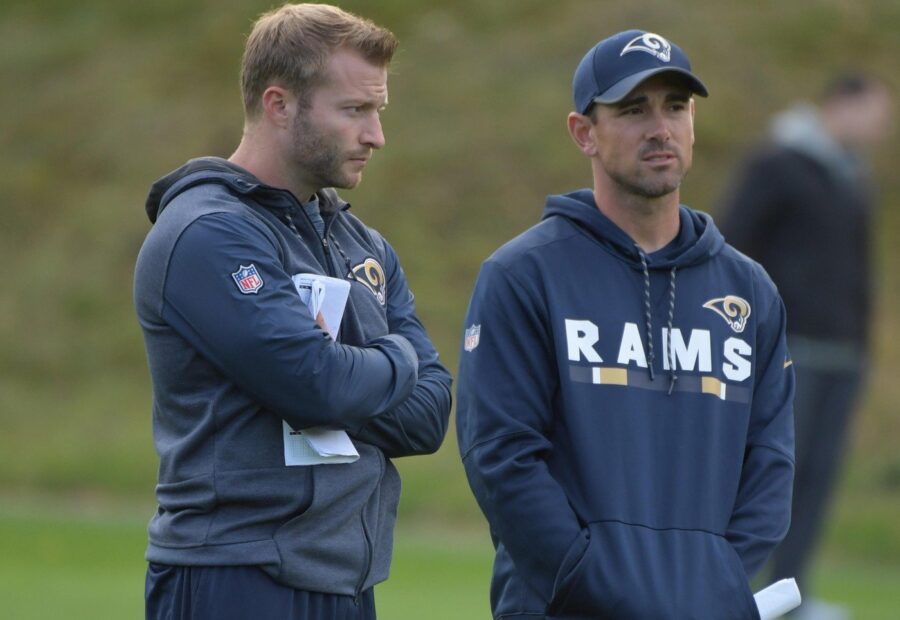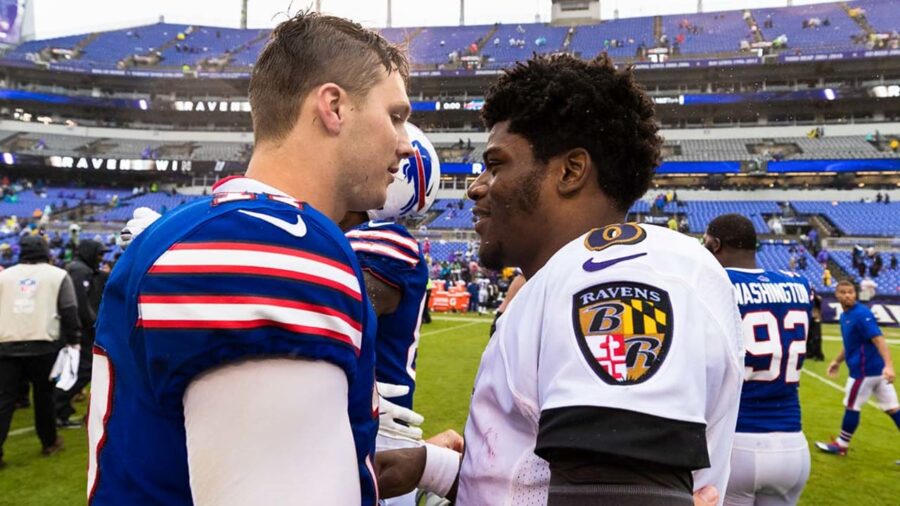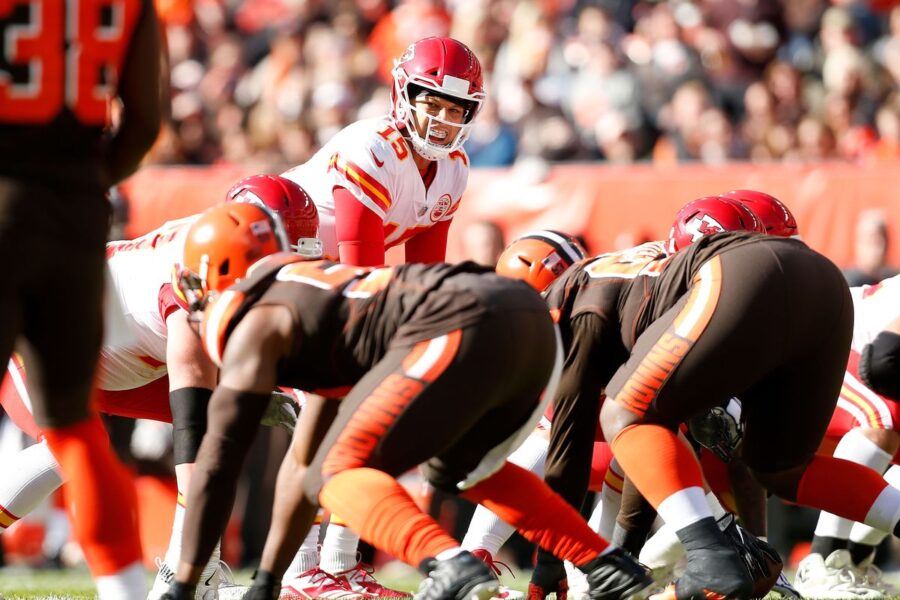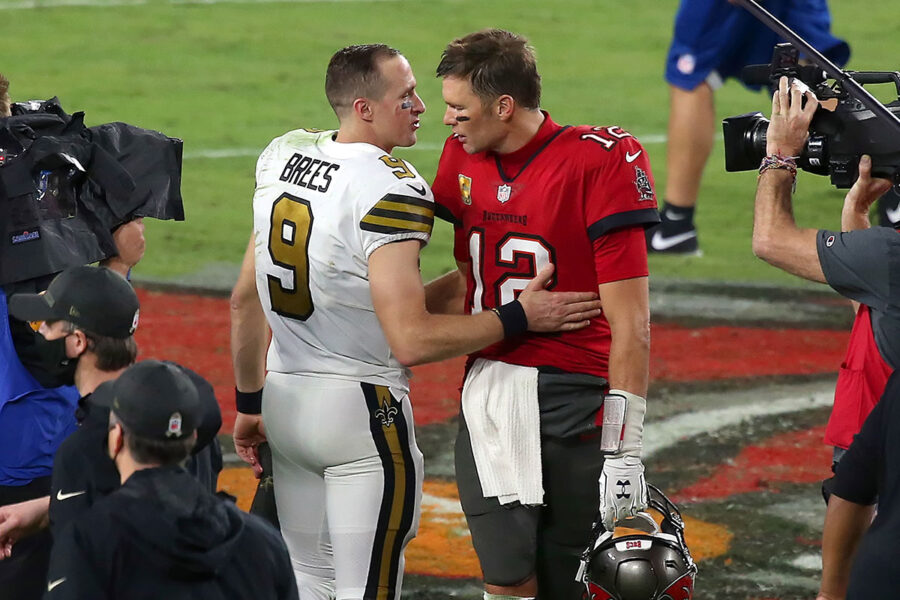Divisional Round Preview: What Will Be The Deciding Factors In This Weekend's Games?
Six epic contests on Wildcard Weekend leaves just eight teams standing. Owen Ravenna takes a look at the four matchups in the Divisional Round of the playoffs, and where each battle will be won and lost…
Divisional Saturday
Los Angeles Rams @ Green Bay Packers

This NFC matchup is a matter of strength vs. strength in many ways. The Rams’ defense is one of the best in the NFL, while the Packers equally boast one of the league’s best offenses. Moreover, the Rams’ passing game was strong for stretches during the season, although has suffered with QB injuries and play over the past month, and is also facing one of the top secondaries in the league.
The Rams will lean on the run to take pressure off both QB Jared Goff and WR Cooper Kupp who are dealing with injuries, but will also aim to control the clock if they can avoid falling too far behind. With their OGs pulling to the outside, the Rams can avoid running at DT Kenny Clark too often and use a zone scheme to get Cam Akers and Malcolm Brown into the second level. This will help the Rams set up play action as well, where they can get the TEs and slot WR open with late releases, using both on crossing routes and an outside WR on a deeper in route to give Goff easier reads. This will also draw the Safety out of the middle of the field, leaving the underneath or deeper receiver in single coverage with a clearer throwing lane.
The WRs (slot and outside) will also run a range of routes, including curls, 7s and vertical-based routes, giving a quick release often and keeping the ball away from the DBs breaking inside or jumping routes to disrupt passes. However, without many big plays, the Rams are relying on keeping in touch on the scoreboard. To help that, they will need their defense to continue holding their own, especially if DT Aaron Donald is less than 100%. While CB Jalen Ramsay will be tasked with containing WR Davante Adams, the latter will likely find a way to get open a few times with double moves, in-breaking routes downfield, comebacks and screens, and the Packers need to hit him when these chances arise.
Against one of the stingiest pass defenses, the Packers need to also get their other players open in different ways than usual. While their TEs typically run short out routes and screens, the Rams will leave a CB and a LB/Safety on each side to either jump the route, as Darious Williams did against the Seahawks in the Wildcard Round, or prevent YAC up the sideline. The bulk of the passing attack will fall to RB Aaron Jones and fellow WRs Allen Lazard and Marquez Valdes-Scantling. Jones will run wheel and swing routes to the outside, as well as some underneath curls and slants, while Lazard will run vertical routes along the sideline, and Valdes-Scantling on a mixture of vertical routes, slants and out routes. LB Micah Kiser will be used often against Jones and TE Tonyan, with one of the Safeties at all times deep to provide protection against Lazard, Adams or Valdes-Scantling getting behind the CBs.
The Packers will also use their RBs on draws and power runs up the middle, especially when the Rams are in nickel formation, aiming to exploit the extra space in the middle. While Los Angeles will ‘spy’ the RBs partially with LB Kenny Young, TE Marcedes Lewis will provide an extra blocker at times to further create holes for the RBs. Green Bay’s offense has plenty of individual talent, but the scheme and awareness of the Rams, especially with a formidable pass rush, can keep them in check for much of the game. While the Packers should be able to score plenty of points, without their OL at full strength, they will need to use a quick-passing game and will be reliant on the rushing attack as well, more than they usually do. The Rams’ offense is unlikely to score on every drive, but winning the field position battle will be essential, and is where their own running game could give them an advantage.
Baltimore Ravens @ Buffalo Bills

With QBs Josh Allen and Lamar Jackson redeeming themselves last week from a year ago, both the Bills and Ravens will favour their chances of making their first AFC Championship Game. In what could be a snowy game, both teams will favour their chances to run the ball, which would give the Ravens a slight edge as the better rushing attack and run defense.
After successfully shutting down the 2020 rushing champion, Derrick Henry, the Ravens will approach Buffalo’s ground game in a similar manner. Although they added an extra LB to the box at times, the Ravens’ DL was able to stop Henry at the line of scrimmage and allowed few yards after contact. While the Bills lost RB Zach Moss to an ankle injury, they still have Devin Singletary as their lead back, who will be run both up the middle and to the outside.
With Allen also able to run the ball, the Ravens will focus on playing contain against these two and avoid having them escape the pocket. LJ Fort and Jihad Ward will each see time as the extra LB to attack the A and B gaps against Singletary, and to sit on the outside to prevent a free runner into space. The Bills will use their TEs and OL movement more than the Titans did to get Singletary to the outside with blockers, but the Ravens tend to have a downfield Safety that will add an extra would-be tackler. Buffalo are also more pass-happy than they are run-heavy, but don’t vary their passing game significantly from week-to-week. With WR Stefon Diggs mostly used on intermediate crossing routes, it frees up space on the outside and draws the deep Safety in, allowing the vertical receivers of John Brown and Gabriel Davis to get open against single coverage. WR Cole Beasley provides a shallow target on drag routes and curls, while the TEs predominantly run short and intermediate out routes.
There are variations to how these players are used together, with some changes to route concepts at times with flood, dagger and hi-lo as the main basis. Allen doesn’t roll out of the pocket extensively, but will at times to his right, usually targeting the TE on the outside or Diggs as he completes his route over the middle, with each of these aspects of the passing game designed to give Allen easier progressions from either deep to short or right to left depending on the play design. Baltimore will use both CBs Marcus Peters and Marlon Humphrey against Diggs to see who has more success early on against him, with the other taking the outside receiver on the other side of the field.
CB Jimmy Smith will frequently defend the TE but will at times play the deep safety role, freeing the Ravens up to disguise the blitzers. Their LBs will mostly be in coverage against the RBs and shallower receivers, but ultimately closing down Diggs is the key to Baltimore’s success on defense. Pressuring Allen, or preventing him from moving to his right, will be effective as well, but taking away Allen’s top target will stagnate the offense the best.
Baltimore’s game plan is relatively straightforward, even if their run attack isn’t. Between their main RBs, Gus Edwards and JK Dobbins, the Ravens will mostly run between the tackles, trusting these two to add yards after contact, which they are among the best in the league at doing, whereas the Bills have struggled to restrict players from adding YAC. Added to this will be their moving TEs, FB and OL so that a range of players are moving in different directions, hiding not only who the ball carrier is, but the direction they are running.
QB Lamar Jackson will have some designed runs, but has been shifting to making reads and running rather than it being the specific playcall. When the Bills present a lighter box, Baltimore will use fake handoffs to make Jackson the runner, often with an option to toss the ball to Dobbins on the outside. Buffalo tend to use nickel formation as their base defense, but may choose to add an extra LB to counteract the extra blockers and add more size to their defense. LBs Matt Milano and Tremaine Edmunds will cover the middle and be tasked with closing down holes along the DL, as well as covering runs to the outside.
Buffalo’s DBs will be used in the box against the run too, but need to keep Jackson on their inside so that other defenders can get to him as he cuts back. Additionally, the Bills’ DBs should win their matchups with the Ravens’ WRs, although have struggled to cover TEs in recent weeks, offering Mark Andrews as a friendly option for Jackson to target in the passing game. The WRs will be used on the outside mainly, instead of over the middle, with Marquise Brown as the main downfield target. CB Tre’Davious White will cover Brown, and should limit him from having too many completions, although could be beaten downfield at times with Brown’s speed.
Buffalo will trust their secondary to win the air battle, but if they can’t have success against the run, will need to make sure their own offense puts up enough points to force the Ravens to throw later in the game.
Divisional SUNDAY
Cleveland Browns @ Kansas City Chiefs

Cleveland will look to continue their fairy tale run against the defending Super Bowl champions. Both teams have had strong offenses for most of the season, with Kansas City 6th in scoring and Cleveland 14th, although neither had shut-down defenses. For the Chiefs, their highest wins were by 26 and 27 points in Weeks 7 and 8, and after that time their highest margin of victory was 6 points. The Browns scored 20 or more points in 12 games this season (winning 11 of those), but had just two double-digit wins (Washington, Giants) and finished the regular season with a negative points differential.
Whichever team can get more stops will have a major advantage, with turnovers even more critical, as they always are. Cleveland have been able to adapt their strategy to be more pass or run heavy as needed, and will likely be slightly run-heavier against the Chiefs until they reach the red zone, as the latter are equal 16th in rushing yards per carry allowed, but equal 10th in rushing TDs allowed, whereas they are equal 10th-worst in passing TDs allowed.
The Browns can exploit the LBs of the Chiefs, especially with pre-snap motions and extra blockers, allowing them to use extra counters, draws and RB screens as extensions of their running plays. Kansas City’s LBs frequently leave space on the backside, and in addition to the RBs cutting back to the opposite side of the field as the OL pushes, also lends itself to the Browns’ use of WRs on reverses and end arounds, where the second handoff sends the WR into the backside of the field.
With shorter and intermediate curls and comebacks by the TEs, as well as the WRs on mostly vertical routes on the outside, Cleveland won’t take too many deep shots. While WR Rashard Higgins could be targeted if he can get behind the defense, the Chiefs tend to try and keep the offense in front of them in a ‘bend-don’t-break’ mentality. Kansas City will play with nickel formations often, using their extra DB and one of the Safeties in the box, covering the TEs if they split out as a receiver, otherwise targeting the RB. LBs Anthony Hitchens, Damien Wilson and Willie Gay Jr will also need to remain in the middle of the field and avoid shooting a gap too early, so that they can defend against the run better.
The Chiefs will prioritise restricting the run, but need to also pressure QB Baker Mayfield, so they can force the Browns into having to pass to move the ball. The Chiefs’ own offense will use its dynamic approach to attack wherever they feel there is a weakness, which is primarily through the air against Cleveland. While the Browns’ DL should be able to collapse the pocket often enough, QB Patrick Mahomes can scramble to extend plays, but should instead look for quick passes with TE and RB screens to counteract blitzes.
The Chiefs should also run the ball regularly, especially with RB Clyde Edwards-Helaire potentially back from injury, so that the Browns don’t sit back against the pass. Kansas City can then use their RBs as outside receivers so that they get greater variation from the same formations, using the agility of the RBs on the outside against the LBs, or leaving TE Travis Kelce to be defended by a LB instead. The Chiefs will use their own WRs as rushers too, and will mix up their pre-snap motions to have all positions moving at different times, to set up fake handoffs, play action and have their entire offense move in two different directions after the snap. The ‘crossing’ style plays of the WRs on drag routes or coming out of the backfield, with the OL going the other way, allows Mahomes to either give the ball to the WRs if the defense follows the OL, or throw to a RB, TE or other WR where there will be extra blockers.
The Chiefs will also use vertical routes with their 3WR formations, and will use the speed of these players to score quickly, especially if the game is close, putting pressure on Cleveland’s offense. The Browns’ LBs will struggle to cover the RBs and TEs, and should play zone instead of man to restrict the yardage instead of trying to break up plays, leaving the DBs to track the WRs instead. The Browns will bring a Safety into the box often, but should consider playing both Safeties over the top to defend against the speed of the WRs. Cleveland’s defense rests on its DL getting home, and without that happening, probably won’t be able to go blow for blow with the Chiefs.
Tampa Bay Buccaneers @ New Orleans Saints

In what will be the third meeting between these teams this season, the Buccaneers will be hoping their improved offense can put up enough points to outlast the Saints. While they are a pass-first offense, they will need to avoid the mistakes through the air that they have been prone to. With WRs Mark Evans and Antonio Brown able to win outside matchups, the Saints will need to decide how they use CBs Marshon Lattimore and Janoris Jenkins. Lattimore most likely takes Brown (and at times Chris Godwin) for his shiftiness, as Jenkins is more suited to defending against the vertical routes and deeper slants that Evans runs. This will allow the Buccaneers to use their TEs up the seam and intermediate out routes, with the slot receiver (Godwin or Scotty Miller) on a short crossing route or slant.
With these options spread across the field, QB Tom Brady will avoid throwing at Lattimore, taking a few deep shots to Evans but mostly targeting the inside receivers, especially the TEs. The Saints will use LB DeMario Davis against the TEs at times, but will also use Safety Malcolm Jenkins at others, often playing Cover 1 to protect against broken coverages downfield. The Saints’ Safeties will be allowed to come up at times if the outside CBs are holding their own, restricting the passing lanes for the TEs and slot receivers.
Tampa Bay will need to try and remain balanced as well to open up downfield plays, although the Saints are one of the best in the league against the run, and held the Buccaneers to just 94 total rushing yards combined in their previous meetings. Tampa Bay will hope that RB Ronald Jones II is healthy and can play so that their run game is more dynamic. While RB Leonard Fournette should see a bulk of the carries to keep Jones fresh, Fournette is limited as a receiver as he lacks Jones’ speed. Both will be used across the line, with Fournette suited to a power game between the tackles, but rotating between them both, including as receivers out of the backfield, will allow Tampa Bay to attack all areas of the field.
The Saints’ DL will seek to exploit chances up the middle of the OL, especially with OG Alex Cappa likely out with a broken ankle, and could be their best chance to force the Buccaneers into deeper passing situations, which favours the Saints’ defence. New Orleans’ own offense, while it lacks the star power of Tampa Bay’s, has the benefit of going against a Tampa Bay defense that has struggled against the pass in recent weeks, and has been less effective against the run since losing DL Vita Vea.
The Saints will use RB Alvin Kamara up the middle at times, but will mostly have him head to the outside, including as a receiver, where he can cut inside the OT or stay outside if it looks as though he could beat LBs LaVonte David and Devin White to the edge. Fellow RB Latavius Murray, if healthy, will see a few snaps as a runner up the middle, but occasionally will get asked to pass protect. The Saints will also use QB Taysom Hill on designed runs, and will have him attempt a few passes if the Buccaneers focus on him as a runner, with Kamara or one of the TEs along the sideline. Tampa Bay will ‘spy’ Kamara all game with a LB and occasionally a Safety in the box, although the OL movements can help to negate that by getting in front, and is how New Orleans will need to run the ball for most of the game.
Their passing attack will use WR Michael Thomas over the middle on intermediate routes, using his size to box out defenders. Their other WRs will be used on vertical routes and shallower routes to give the Saints levels to target, and stretch the defense so that they can add yards after the catch. The Buccaneers will leave Safety Antoine Winfield Jr over the top in Cover 1, with their LBs in zones over the middle. CB Carlton Davis could be asked to defend Thomas early on, but could shift to an outside receiver if he is beaten too often, leaving Thomas to be double covered instead. Slot CB Sean Murphy-Bunting will handle the WR2 and WR3 at times, but the Buccaneers lack the quality depth at CB to constantly win matchups with Thomas, TE Jared Cook, WR Emmanuel Sanders and TE Adam Trautman. While the LBs will limit yards gained over the middle, the deeper passes and outside targets will create problems for the Bucs, with Kamara then getting open underneath.
While Tampa Bay’s offense is capable of putting points up, and the defense has playmakers, there are too many holes for Tampa Bay to cover. New Orleans should edge out Tampa Bay, but needs the defense to continue making stops as it has all season.

Owen Ravenna
NFL Analyst
